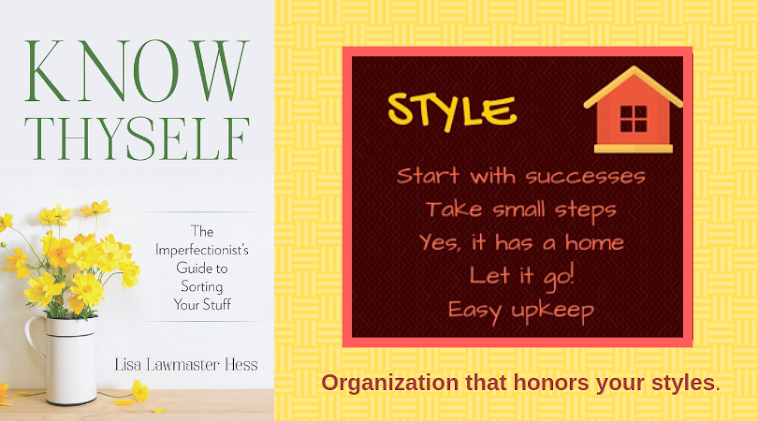I celebrated Fourth of July by declaring my independence from some of the
clutter in my basement (more on that next week). In the process, I discovered several fat binders whose contents need to be reviewed before I toss them wholesale.
One of those binders contained notes and research for what eventually became my book, Know Thyself. In paging through the (color-coded, labeled) sections, I discovered my notes from the very first small group I ran on organization. The group members were third graders at the elementary school where I worked as a school counselor. In the first session, each of these eight-year-olds self-selected their personal and organizational styles. Then, the next time we met, I asked them to share their successes, along with the things that weren't working so well.
As we head into back-to-school shopping season, I thought it might be fun to share their observations and their wisdom before you hit the back-to-school sales with your own kids.
Basic concept #1: Homes. Although they didn't phrase it as such, nearly every third grader in the group identified the concept of homes ("a place for everything") as a key to success. Some of these things included a bag for all the soccer gear, a hamper for dirty clothes, and folders color-coded by subject.
Basic concept #2: One size doesn't fit all. But before you get too excited about those folders, (likely available for 10¢ each at many back-to-school sales), let me warn you that the group was divided on "responsibility folders." These ubiquitous pocket folders are standard tools, with elementary school students practically everywhere labeling one pocket "Bring back" and the other one "Keep at home" as they set up their systems during the first week of school. Most of the group members liked them, but a few did not. One girl cited "name on tab" (file) folders as preferable to pocket folders.
"It all falls out," two of the girls said about the pocket folders, while readily admitting that their papers would be less likely to fall out if they put them in the pockets.
It wasn't that these third graders, who'd been using some version of that folder for at least three years, weren't smart enough to put things in the pockets. Rather, for one reason or another, that tool did not work for them.
Basic concept #3: Like with like. The group was also divided on the "Agenda," a school-issued planner, with about half the group (3 students out of 7) citing it as helpful, and one student saying she preferred tucking her assignments into the Agenda instead of the folder. Again, though she didn't label it as such, she recognized the idea of keeping related items together.
Basic concept #4: Leading a horse to water (so to speak) is only part of the battle. One thing both of these tools (the folder and the planner) have in common is that their use has been modeled by the adult at the front of the room. At the end of the day, teachers allow time for students to copy assignments from the board into the Agenda and put papers in the correct pocket of the "Responsibility Folder." Yet, even with this set-up, less than half of my group of students, most of whom had been trained in this process since at least first grade, used one or both of these tools.
Basic concept #5: Give them ownership. Other times, well-meaning adults complicate the process. One of my group members cited her mom as both a help and a hindrance. Mom's advice and assistance were appreciated but, when her mom put her stuff away in a place that made sense to her (Mom), the student was stymied and frustrated.
This was by no means a well-constructed study; rather, it's a set of observations made by a group of kids who joined a group to learn how to get better organized. Some actually came for that purpose, while others were there because they wanted to hang out in my office at the end of the day or because someone else (usually their teacher) thought they needed to be there. Still, it's the closest thing I have to kid voices on the subject of organizational tools, and the conversation sounds remarkably similar to those I have with adults still struggling to create organizational systems that work.
Before you plunk down a substantial chunk of change on traditional back-to-school tools, perhaps it's worth doing non-scientific study of your own. Ask your child to pinpoint his or her own organizing- for-school successes, and then, perhaps, inject a few observations of your own, making sure to ask them what they think.
Then, if you have flexibility in your school supply selection, let those observations and discussions be your shopping guide. If you must shop for specific tools, perhaps consider doing a little doctoring of the required supplies to make them a better fit, so that the tools work in the service of the student rather than vice versa.
That's exactly what I did with the binders I found in the basement. While binders are rarely my tool of choice, when I add dividers and pockets and clips, they serve as a resource years beyond the time I created them. Sometimes, they even yield organizing gold like the observations of students who are now college graduates.
And the rest of the binders in that bin? When I finish this post, I'm tagging the bin with a sticky note. Anything not sorted by August 1 gets tossed, whether I've gone through it or not because, as my then-third graders pointed out in their examples, it's important to know where things belong and put them there.
And these binders most decidedly do not belong in a bin on the floor in my sunroom, awaiting further action.
Happy shopping.









